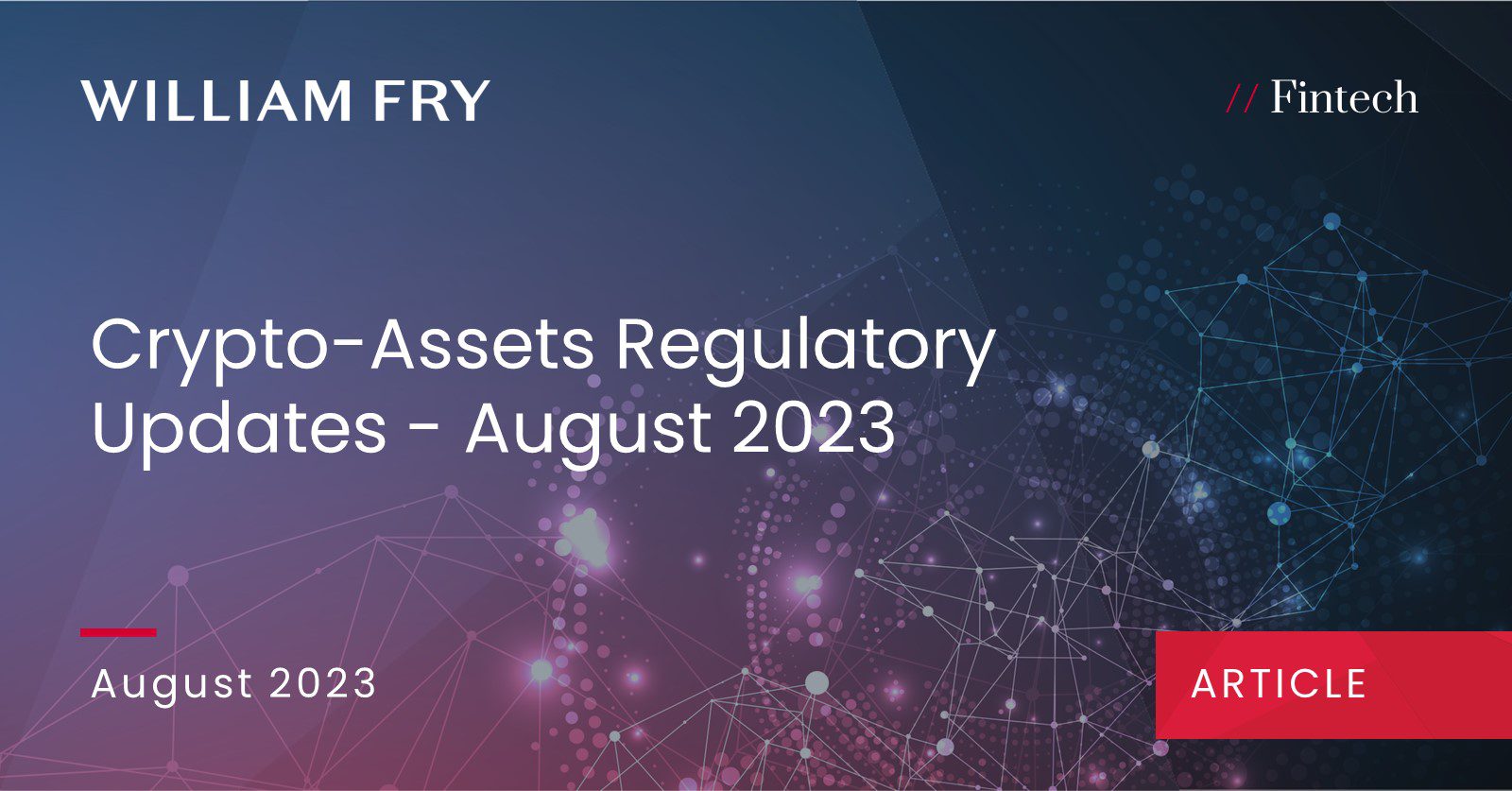The Markets in Crypto-Assets Regulation (Regulation (EU) 2023/1114) (MiCA) entered into force on 29 June 2023.
MiCA provides an EU legal framework to shape the functioning of the EU markets in crypto-assets, which includes transparency rules, authorisation requirements, customer protection rules and an anti-market abuse framework.
Since MiCA entered into force, several related consultations have been launched, domestically and at an EU level.
Also, the Financial Stability Board (FSB), which coordinates at an international level the work of national financial authorities and international standard-setting bodies and develops and promotes the implementation of effective regulatory, supervisory, and other financial sector policies in the interest of financial stability, has finalised a global regulatory framework for crypto-asset activities.
William Fry’s Fintech and Financial Regulation teams examine these and other recent crypto-related regulatory developments below.
A. MiCA Updates
As a regulation, MiCA is a directly effective European Union Level 1 legislative measure which will introduce and harmonise the EU regulatory framework for crypto-assets and crypto-asset service providers (CASPs) not otherwise captured under existing EU financial services regimes.
MiCA requires many Level 2 and Level 3 EU legislative measures such as Regulatory Technical Standards (RTS), Implementing Technical Standards (ITS) and Guidelines under the new regime (i.e. within a 12-to-18-month timeframe, depending on the mandate).
The European Supervisory Authorities (ESAs), being the European Banking Authority (EBA), the European Securities and Markets Authority (ESMA) and the European Insurance and Occupational Pensions Authority (EIOPA) are tasked with developing relevant MiCA Level 2 and Level 3 measures.
Ireland
1. Department of Finance MiCA Consultation
As mentioned above, MiCA, is directly effective. However, there are some provisions in the regulation to which full harmonisation does not apply, and the Member States have discretion as to whether and how to apply these provisions.
On 9 August 2023, the Minister of Finance in Ireland launched a public consultation on the exercise of national discretions under MiCA.
The consultation aims to obtain submissions on the transposition of national discretions included within MiCA.
The four national discretions the Irish national consultation seeks feedback on include:
- Public disclosure of inside information under Article 88 (1) MiCA;
- Administrative penalties and other administrative measures under Article 111 (2) MiCA;
- The MiCA transition period under Article 143 (2) MiCA; and
- Simplified authorisation procedure under Article 143 (6) MiCA.
The Department of Finance invites comments on whether these discretions should be used, how they should be used, and clear reasoning for any such position.
An online consultation portal is now open to allow all stakeholders to submit their views on whether and how Ireland should exercise national discretions contained within MiCA. Alternatively, submissions can be posted to an address on the Department of Finance website.
The consultation period will run until 15 September 2023.
European Union
2. EBA’s first MiCA Consultation Package
The EBA is responsible for developing seventeen sets of technical standards and guidelines to specify the requirements for Asset Referenced Tokens (ARTs) and Electronic Money Tokens (EMTs) further. Under MiCA, the EBA will also supervise significant ARTs and EMTs.
On 12 July 2023, the EBA published its first of three consultation packages under MiCA, seeking feedback on the following draft technical standards:
ART Authorisations
- RTS on information to apply for authorisation to offer to the public and to seek admission to trading of ARTs; and
- ITS on forms, templates and procedures for inclusion in the application, under Article 18(6) and (7) of MiCA.
As credit institutions are only required to receive approval to publish a white paper, these draft RTS and ITS do not apply to credit institutions.
Assessment of proposed acquisitions of qualifying holdings in issuers of ARTs
- RTS on the information necessary to assess a proposed acquisition of qualifying holdings in issuers of ARTs under Article 42(4) of MiCA.
Like similar regimes, MiCA envisages a prudential assessment by competent authorities for the acquisition of qualifying holdings in issuers of ARTs that are not credit institutions. This information covers criteria relating to:
- the reputation of the proposed acquirer,
- the suitability of any person who will direct the target undertaking,
- the financial soundness of the proposed acquirer,
- the sound and prudent management of the target undertaking following the acquisition; and
- suspicion that money laundering or terrorist financing is committed or attempted or may increase following the acquisition.
Complaints handling procedures for issuers of ARTs
- RTS specifying the requirements, templates and procedures for handling complaints under Article 31 of MiCA.
The consultation period will run until 12 October 2023.
3. ESMA’s first MiCA Consultation Package
MiCA requires ESMA, the EU’s financial markets regulator and supervisor, to develop a series of RTS, ITS and Guidelines. ESMA develops many of these technical standards and guidelines in close cooperation with the EBA.
On 12 July 2023, ESMA published its first of three consultation packages under MiCA, containing seven sets of draft technical standards (five draft RTS and two draft ITS).
In the first consultation package, ESMA seeks input on proposed rules for CASPs, relating to authorisation, identification, and management of conflicts of interest and how CASPs should address complaints.
ESMA also aims to gather more insight into respondents’ current and planned activities, as a fact-finding exercise to better understand the EU crypto-asset markets and their future development. In this context, questions relate to the expected turnover of the respondents, the number of white papers they plan to publish and the use of on-chain versus off-chain trading. The input to this part of the consultation will be confidential and influence the second and third consultation packages.
ESMA’s first consultation package covers the following draft technical standards:
- RTS on the notification by certain financial entities to National Competent Authorities (NCAs) of their intention to provide crypto-asset services, under Article 60(13) MiCA.
- ITS on forms, templates and procedures for notification from entities to NCAs, under Article 60(14) MiCA.
- RTS on the content of the application for authorisation for CASPs, under Article 62(5) MiCA.
- ITS on forms, templates and procedures for CASP authorisation under Article 62(6) MiCA.
- RTS on complaints handling by CASPs, under Article 71(5) MiCA.
- RTS on identification, prevention, management and disclosure of conflicts of interest, under Article 72(5) MiCA.
- RTS on the proposed acquisition of a qualifying holding in a CASP under Article 84(4) MiCA.
The consultation period will run until 20 September 2023.
4. EBA Statement and Guiding Principles
On 12 July 2023, the EBA published a statement for the attention of financial institutions and other undertakings who intend to commence, or have started, ART or EMT activities before 30 June 2024 (the application date for related MiCA provisions) and for competent authorities.
The statement encourages applicant firms to take timely preparatory actions for MiCA. It includes guiding principles to which firms conducting ART/EMT activities should have regard until the application date. These guiding principles include:
- disclosures to, and fair treatment of, potential acquirers and holders of ARTs and EMTs,
- the business model,
- sound governance, including effective risk management,
- reserve, recovery and redemption arrangements; and
- communications with the relevant competent authority.
The statement was published with a template that relevant applicant firms should use when communicating with the NCA in the transition phase to the application of Titles III and IV of MiCA (i.e. 30 June 2024).
5. MiCA Implementation Timeframe
MiCA implementation milestones are as follows:
| Date | Event |
|---|---|
| 29 June 2023 | MiCA enters into force. |
| 12 July 2023 | ESMA and EBA publish first consultation packages. |
| Q3 2023 | ESMA and EBA to publish second consultation packages. |
| Q4 2023 | EBA expects to have published all remaining consultation packages before the end of 2023. |
| Q1 2024 | ESMA expects to publish a third consultation package. |
| 30 June 2024 | The rules of stable-coins (Title III) and (Title IV) apply. |
| 30 December 2024 | MiCA applies in full. |
B. FSB finalises rules for crypto-assets
The G20 tasked the FSB to coordinate the delivery of an effective regulatory, supervisory and oversight framework for crypto-assets.
On 17 July 2023, the FSB published a finalised version of its global regulatory framework for crypto-asset activities to promote the comprehensiveness and international consistency of regulatory and supervisory approaches. The framework takes account of recent industry developments and feedback received during the FSB’s public consultation, which closed on 15 December 2022.
The framework consists of two sets of recommendations, including:
- High-level recommendations for the regulation, supervision and oversight of crypto-asset activities and markets.
- Revised high-level recommendations for the regulation, supervision, and oversight of global stable-coin arrangements.
Due to recent turbulence in the crypto market, the FSB has, in its finalised framework, strengthened both sets of high-level recommendations in three areas: (i) safeguarding of client assets; (ii) conflicts of interest; and (iii) cross-border cooperation.
The recommendations focus on addressing risks to financial stability and do not cover all risk categories related to crypto-asset activities. For example, Central Bank Digital Currencies (CBDCs) are not subject to these recommendations. Please see our article here for further information on EU proposals to introduce a Digital Euro.
Key FSB recommendations include the following:
- Regulatory powers and tools. Authorities should have appropriate powers, tools, and adequate resources to regulate, supervise, and oversee crypto-asset activities and markets and effectively enforce relevant laws and regulations.
- General regulatory framework. Authorities applying regulation, supervision, and oversight to crypto-asset activities and markets – including crypto-asset issuers and service providers – on a functional basis and proportionate to the financial stability risk they pose, or potentially pose, and consistent with authorities’ respective mandates in line with the principle “same activity, same risk, same regulation”.
- Cross-border cooperation, coordination and information sharing between authorities for communication, information sharing, consultation, support, and to encourage consistency of regulatory and supervisory outcomes.
- Governance. Relevant authorities should require crypto-asset issuers and service providers to implement a comprehensive governance framework with clear and direct lines of responsibility and accountability for all their functions and activities. The governance framework should be proportionate to their risk, size, complexity and systemic importance and to the financial stability risk that may be posed by activity or market in which the crypto-asset issuers and service providers are participating. It should provide clear and direct lines of responsibility and accountability for their functions and activities.
- Risk management. Relevant authorities should require crypto-asset issuers and service providers to have an effective risk management framework that comprehensively addresses all material risks associated with their activities. The framework should be proportionate to the risk, size, complexity, and systemic importance and to the financial stability risk that may be posed by the activity or market in which they participate. Authorities should, to the extent necessary to achieve regulatory outcomes comparable to those in traditional finance, require crypto-asset issuers to address the financial stability risk that may be posed by the activity or market in which they are participating.
- Data collection, recording and reporting. Relevant authorities should require crypto-asset issuers and service providers to have robust frameworks, including systems and processes, for collecting, storing, safeguarding, and the timely and accurate reporting of data, including relevant policies, procedures and infrastructures needed, in each case, proportionate to their risk, size, complexity and systemic importance. Authorities should have access to the data as necessary and appropriate to fulfil their regulatory, supervisory and oversight mandates.
- Disclosures. Relevant authorities should require crypto-asset issuers and service providers to disclose to users and relevant stakeholders comprehensive, clear and transparent information regarding their governance framework, operations, risk profiles and financial conditions, as well as the products they provide and activities they conduct.
- Addressing financial stability risks arising from interconnections and interdependencies. Authorities should identify and monitor the relevant interconnections, both within the crypto-asset ecosystem and between the crypto-asset ecosystem and the wider financial system. Authorities should address financial stability risks that arise from these interconnections and interdependencies.
- Comprehensive regulation of crypto-asset service providers with multiple functions. Authorities should ensure that crypto-asset service providers and their affiliates that combine multiple functions and activities, where permissible, are subject to appropriate regulation, supervision and oversight that comprehensively address the risks associated with individual functions and the risks arising from the combination of functions, including but not limited to requirements regarding conflicts of interest and separation of certain functions, activities, or incorporation, as appropriate.
Please see our recent MiCA publications here and here for further information.
Contact Us
For more information, please contact Shane Kelleher, Louise McNabola, John O’Connor or your usual William Fry contact.
Contributed by Jane Balfe




